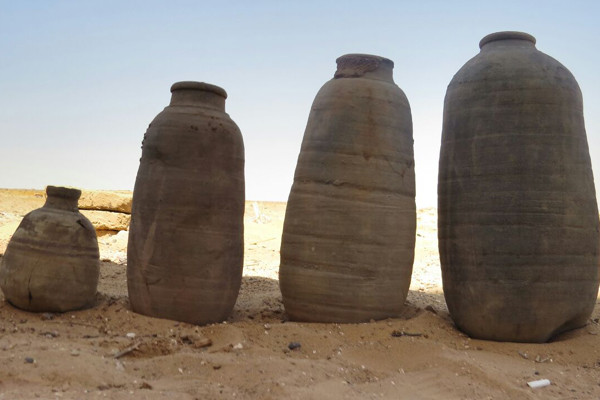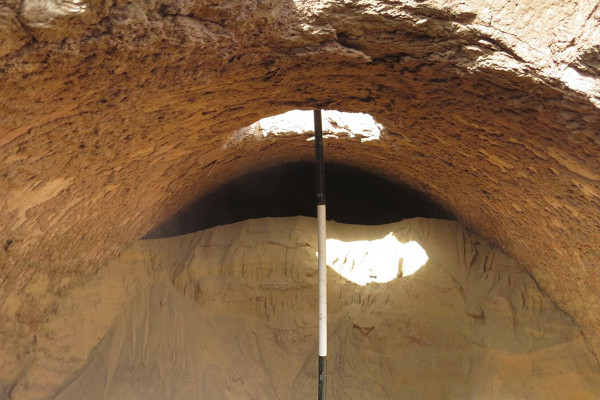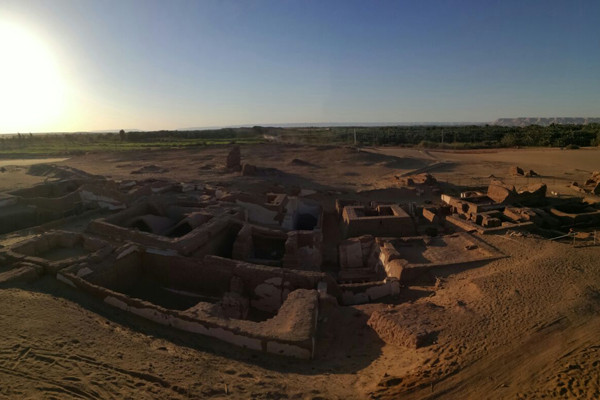New Roman tombs discovered in Dakhla Oasis, Egypt
- The glittering gold warehouse in the ancient Egyptian tomb of Pharaoh Tutankhamun
- The mystery of the ancient Egyptian helicopter, the disappearance of the Nazca civilization . finally has a solution
The Egyptian Archeology Department discovered five Roman tombs in excavations carried out in the Beir Al-Shaghala area at Dakhla Oasis in the western desert of Egypt.
Ayma Ashmawi, Head of Ancient Archaeological Department of Egypt explained that these tombs were built with mud bricks and had different architectural styles.
The first tomb has an entrance leading to a rectangular room with two burial chambers, while the second tomb is placed in an area with a vaulted ceiling and its entrance leads to a burial chamber.

The third tomb is a pyramid-shaped tomb.
The fourth and fifth tombs lead the entrance and each grave has a separate burial chamber with a vaulted ceiling above.
Ashmawy points out that further excavations in this area will also continue.

Gamal Al-Semestawi, general manager of the Central Egyptian Archeology Department, said some artifacts were found inside the tombs, including the rest of the funeral mask, depicting a human face. painted in yellow, a different shape and size pottery, as well as two ostraca pots, one of which contains hieroglyphic text, while the second is written in Hieratic.

In addition, they found a scent of clay made of small, 14 cm tall clay placed inside graves.
Magdi Ibrahim, General Manager of the Dakhla Oasis Institute and the head of the excavation, said it was a successful excavation during the previous six excavations, having discovered 8 Roman tombs in a well-preserved state. and with the same architectural design. They consist of a rectangular tissue room and two adjacent chambers with vaulted ceilings made of mud bricks are found.

The Al-Shaghala area to the west of Mout City is 3 km from the Dakhla oasis located between three different archaeological sites.
You should read it
- Excavation of a thousand-year-old Egyptian tomb reveals the mummy in an 'intact' state.
- The 1,600-year Roman tomb with ancient coins was discovered in Somerset
- The groundbreaking archaeological findings about ancient Egypt
- Egypt's 7000-year-old city may shed light on the earliest civilization in the Nile valley
- Found traces of the ancient Roman Battlefield in Jerusalem
- The 'eccentricities' are only found in ancient Egypt
- Found four Roman rust coins in Japan yet explanation
- Greco-Roman mummy was discovered in Fayoum
May be interested
- The groundbreaking archaeological findings about ancient Egypt
 so far, archaeologists have made many important discoveries about ancient egypt: tombs, mummies, pyramids, inventions before time ... around them there are always mysteries. strange makes scientists headaches.
so far, archaeologists have made many important discoveries about ancient egypt: tombs, mummies, pyramids, inventions before time ... around them there are always mysteries. strange makes scientists headaches. - Many relics are found in the Roman graveyard at Alderney
 more roman artifacts were discovered in a graveyard hole in alderney.
more roman artifacts were discovered in a graveyard hole in alderney. - Egypt's 7000-year-old city may shed light on the earliest civilization in the Nile valley
 archaeologists in egypt discovered the ruins of an ancient city and an adjacent cemetery dating from 7000 to 5.3 bc. according to a statement by the archaeological department, this site may have originated from the first dynasty of egypt.
archaeologists in egypt discovered the ruins of an ancient city and an adjacent cemetery dating from 7000 to 5.3 bc. according to a statement by the archaeological department, this site may have originated from the first dynasty of egypt. - The 2000-year-old road was excavated at Bet Shemesh
 an ancient 2000-year-old ancient road discovered at bet shemesh received the interest of archaeologists.
an ancient 2000-year-old ancient road discovered at bet shemesh received the interest of archaeologists. - Announcing a series of ancient Roman artifacts discovered in Wales
 it took nearly a year to excavate, the welsh archaeologists now officially publish a collection of ancient roman artifacts and interesting stories around.
it took nearly a year to excavate, the welsh archaeologists now officially publish a collection of ancient roman artifacts and interesting stories around. - Found traces of the ancient Roman Battlefield in Jerusalem
 a series of new archaeological evidence newly unearthed in jerusalem is judged to be related to some ancient roman battlefield.
a series of new archaeological evidence newly unearthed in jerusalem is judged to be related to some ancient roman battlefield. - The 'eccentricities' are only found in ancient Egypt
 until now, researchers have discovered a number of mysteries about humans, ancient egyptian customs such as golden skincare, cat worship, using giraffes as gifts to show strength. ..
until now, researchers have discovered a number of mysteries about humans, ancient egyptian customs such as golden skincare, cat worship, using giraffes as gifts to show strength. .. - The strange object is from ancient Roman times, the mystery cannot be decoded
 the blocks of twelve-sided, hollow objects that appeared from 200 ad were discovered by archaeologists in the present-day france and southwestern germany but without any notes about the mass this strange body.
the blocks of twelve-sided, hollow objects that appeared from 200 ad were discovered by archaeologists in the present-day france and southwestern germany but without any notes about the mass this strange body. - The mummy found in the tomb of Elephantine may be at the end of the ancient Egyptian period
 the 3d x-ray sweeps on two mummies were discovered during excavation at the elephantine tomb, west of aswan, suggesting that the mummy may be of late egypt.
the 3d x-ray sweeps on two mummies were discovered during excavation at the elephantine tomb, west of aswan, suggesting that the mummy may be of late egypt. - Archaeologists explore the 2,000-year-old tomb in Alexandria and 300 strange artifacts
 a 2,000-year-old tomb contains about 300 artifacts surveyed by a group of egyptian archaeologists at alexandria.
a 2,000-year-old tomb contains about 300 artifacts surveyed by a group of egyptian archaeologists at alexandria.










 The old 4,000-year-old dagger was suddenly found in Slovakia
The old 4,000-year-old dagger was suddenly found in Slovakia Artifacts of stores and warehouses for thousands of years are found in Turkey
Artifacts of stores and warehouses for thousands of years are found in Turkey Excavation of a 1,000-year-old King's tomb of the Mayan discovered strange things
Excavation of a 1,000-year-old King's tomb of the Mayan discovered strange things Two Kannada inscriptions were suddenly found
Two Kannada inscriptions were suddenly found Detecting tremors about the ancient Egyptians confused the scientific world
Detecting tremors about the ancient Egyptians confused the scientific world The 1,400-year-old stone tablet reveals the dreadful Mayan custom
The 1,400-year-old stone tablet reveals the dreadful Mayan custom